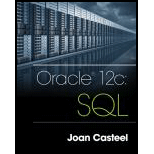
Oracle 12c: SQL
3rd Edition
ISBN: 9781305251038
Author: Joan Casteel
Publisher: Cengage Learning
expand_more
expand_more
format_list_bulleted
Textbook Question
Chapter 2, Problem 7MC
Which of the following is a valid SELECT statement?
- a. SELECT TITLES * TITLE! FROM BOOKS;
- b. SELECT “customer#” FROM books;
- c. SELECT title AS “Book Title” from books;
- d. all of the above
Expert Solution & Answer
Trending nowThis is a popular solution!

Students have asked these similar questions
How can I perform Laplace Transformation when using integration based on this?
Write an example of a personal reflection of your course.
- What you liked about the course.
- What you didn’t like about the course.
- Suggestions for improvement.
Course: Information and Decision Sciences (IDS)
The Reflection Paper should be 1 or 2 pages in length.
How can I perform Laplace Transformation when using integration ?
Chapter 2 Solutions
Oracle 12c: SQL
Ch. 2 - Prob. 1RQCh. 2 - What are the two required clauses for a SELECT...Ch. 2 - What is the purpose of the SELECT statement?
Ch. 2 - What does an asterisk () in the SELECT clause of a...Ch. 2 - What is the purpose of a column alias?Ch. 2 - How do you indicate that a column alias should be...Ch. 2 - When is it appropriate to use a column alias?
Ch. 2 - What are the guidelines to keep in mind when using...Ch. 2 - Prob. 9RQCh. 2 - What is a NULL value?
Ch. 2 - Which of the following SELECT statements displays...Ch. 2 - Which clause is required in a SELECT...Ch. 2 - Which of the following is not a valid SELECT...Ch. 2 - Which of the following symbols represents...Ch. 2 - Prob. 5MCCh. 2 - Prob. 6MCCh. 2 - Which of the following is a valid SELECT...Ch. 2 - Which of the following symbols is used in a SELECT...Ch. 2 - Prob. 9MCCh. 2 - When must a comma be used in the SELECT clause of...Ch. 2 - Prob. 11MCCh. 2 - Which clause is not required in a SELECT...Ch. 2 - Which of the following lines of the SELECT...Ch. 2 - Which of the following lines of the SELECT...Ch. 2 - Which of the following lines of the SELECT...Ch. 2 - Which of the following lines of the SELECT...Ch. 2 - Which of the following lines of the SELECT...Ch. 2 - Which of the following lines of the SELECT...Ch. 2 - Which of the following lines of the SELECT...Ch. 2 - Which of the following lines of the SELECT...Ch. 2 - Prob. 1HOACh. 2 - Prob. 2HOACh. 2 - Prob. 3HOACh. 2 - Prob. 4HOACh. 2 - Prob. 5HOACh. 2 - Prob. 6HOACh. 2 - Prob. 7HOACh. 2 - Create a list of each book title stored in the...Ch. 2 - Prob. 9HOACh. 2 - List all information for each order item. Include...
Knowledge Booster
Learn more about
Need a deep-dive on the concept behind this application? Look no further. Learn more about this topic, computer-science and related others by exploring similar questions and additional content below.Similar questions
- I need help in explaining how I can demonstrate how the Laplace & Inverse transformations behaves in MATLAB transformation (ex: LIke in graph or something else)arrow_forwardYou have made the Web solution with Node.js. please let me know what problems and benefits I would experience while making the Web solution here, as compared to any other Web solution you have developed in the past. what problems and benefits/things to keep in mind as someone just learningarrow_forwardPHP is the server-side scripting language. MySQL is used with PHP to store all the data. EXPLAIN in details how to install and run the PHP/MySQL on your computer. List the issues and challenges I may encounter while making this set-up? why I asked: I currently have issues logging into http://localhost/phpmyadmin/ and I tried using the command prompt in administrator to reset the password but I got the error LOCALHOST PORT not found.arrow_forward
arrow_back_ios
SEE MORE QUESTIONS
arrow_forward_ios
Recommended textbooks for you

 A Guide to SQLComputer ScienceISBN:9781111527273Author:Philip J. PrattPublisher:Course Technology Ptr
A Guide to SQLComputer ScienceISBN:9781111527273Author:Philip J. PrattPublisher:Course Technology Ptr Programming with Microsoft Visual Basic 2017Computer ScienceISBN:9781337102124Author:Diane ZakPublisher:Cengage Learning
Programming with Microsoft Visual Basic 2017Computer ScienceISBN:9781337102124Author:Diane ZakPublisher:Cengage Learning- Np Ms Office 365/Excel 2016 I NtermedComputer ScienceISBN:9781337508841Author:CareyPublisher:CengageCOMPREHENSIVE MICROSOFT OFFICE 365 EXCEComputer ScienceISBN:9780357392676Author:FREUND, StevenPublisher:CENGAGE L


A Guide to SQL
Computer Science
ISBN:9781111527273
Author:Philip J. Pratt
Publisher:Course Technology Ptr

Programming with Microsoft Visual Basic 2017
Computer Science
ISBN:9781337102124
Author:Diane Zak
Publisher:Cengage Learning

Np Ms Office 365/Excel 2016 I Ntermed
Computer Science
ISBN:9781337508841
Author:Carey
Publisher:Cengage

COMPREHENSIVE MICROSOFT OFFICE 365 EXCE
Computer Science
ISBN:9780357392676
Author:FREUND, Steven
Publisher:CENGAGE L
How to Design DB Tables for any Application? (The Basics); Author: Studytonight;https://www.youtube.com/watch?v=XUdNVaSikqY;License: Standard YouTube License, CC-BY
Create a Table (Introduction to Oracle SQL); Author: Database Star;https://www.youtube.com/watch?v=BiV1IrzB1sY;License: Standard Youtube License